1995 Oldsmobile Cutlass Supreme brake fluid
[x] Cancel search: brake fluidPage 159 of 340
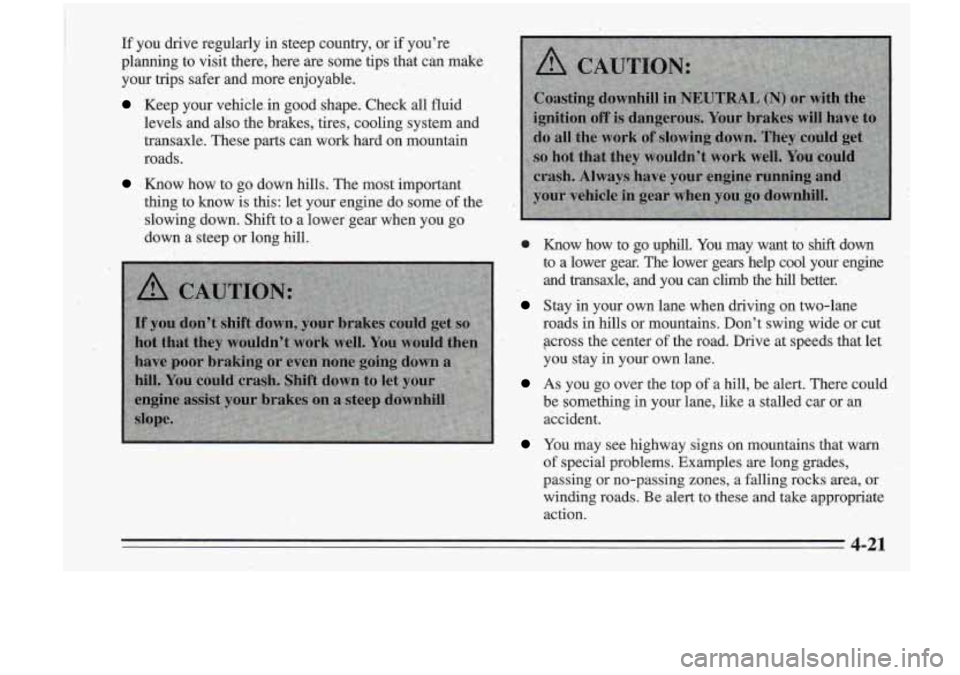
If you drive regularly in steep country, or if you're
planning to visit there, here are some tips that can make
your trips safer and more enjoyable.
Keep your vehicle-in good shape. Check all fluid
1evel.s and. also the brakes; tires, cooling system and
..
transaxle. These parts can work,hard on mountain
roads.
Know how to go down hills. The most important
thing to know is this: let your' engine do some of the
slowing down. Shift to a lower, gear when you go
down a steep or long hill.
e Know, how to gauphill. You may want to shift down
to a lower gek The 1ower.gearshelp cool your engine
and tramaxle, and you can climb the hill better.,
Stay in your own lane when driving on two-lane
roads
iri hills or mountains. Don't swing wide or cut
'% across the center of the road, Drive at speeds that let
you stay
in your own lane.
As you go over the top of a hill, be alert. There, dould
be something in your lane, like a stalled ca~
or an
accident.
You.m&y see highway ,signs on mountains that warn
,of special problems. Examples are long grades,
passing
or no-passing zones, a falling rocks &ea, or
winding roads. Be aleq to these aad'take appropriate
action.
,,
4-21
Page 172 of 340
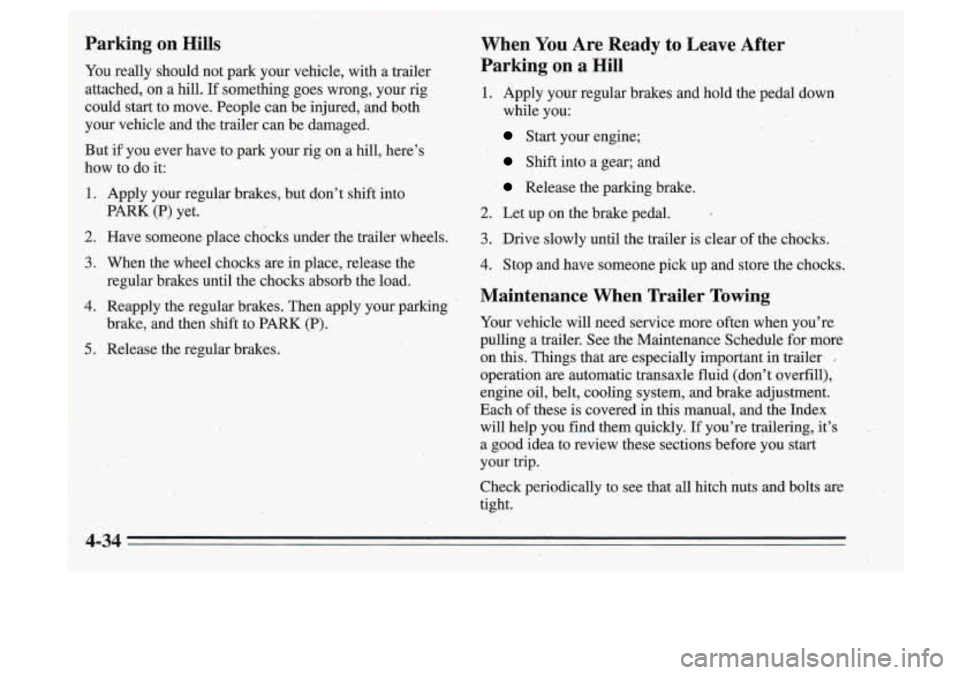
Parking on Hills
You really should not park your vehicle, with a trailer
attached,
on a hill. If something goes wrong, your rig
could start to move. People can be injured, and
both^
your vehicle and the trailer can be darnaged.
But if you ever have to park your rig on a hill, here’s
how to do it:
.I. Apply your regular brakes, but don’t shift into
.. !PARK (P) yet.
2. ‘Have someone place chocks under the trailer wheels.
3. When the wheel chocks are in place, release the
regular brakes until the chocks absorb the load.
4. Reapply the regular brakes. Then apply your parking
brake, and then shift to PARK
(P).
When You Are Ready to Leave After
Parking o,n a
Hill
1. Apply your regular brakes and hold the pedal down
8’. .
while you:
Start your engine;
Shift into a gear; and
Release the parking brake.
2. Let up on the brake pedal.
3. Drive slowly until the trailer is dear of the chocks.
4. Stop and have someone pick up and store the chocks.
Maintenance When Trailer Towing
Your vehicle will need service more often when you’re
pulling a trailer. See the Maintenance Schedule for,more
.on this. Things that are especially important in trailer
operation are automatic transaxle fluid (don’t oyerfill),
engine oil, belt, cooling system, .and brake adjustment.
Each of these
is covered in this manual, and the Index
will help you find them quickly. If you’re trailering, it’s
a good idea
to review these sections before you start
your trip.
Check periodically to see that all hitch nuts and bolts are
tight.
4-34,
Page 213 of 340

With the 3.4L LQ1 (Code X) engine, when you open the hood, you’ll see:
1. Radiator Pressure Cap
2. Engine Coolant Reservoir
3. Power Steering Fluid Reservoir
4. Electric Engine Fans
5. Engine Oil Dipstick
6. Engine Oil Fill Cap
7. Coolant Bleed Valves
8. Automatic Transaxle Fluid Dipstick
9. Brake Fluid Reservoir
10. Air Cleaner
11. Windshield Washer Fluid Reservoir
6-9
Page 221 of 340
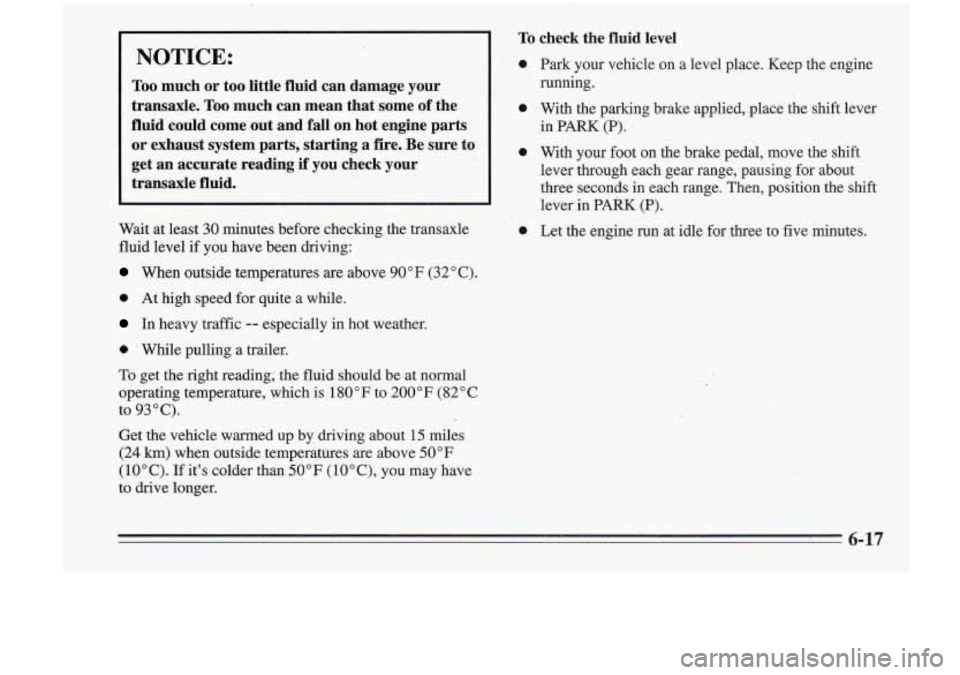
NOTICE:
Too much or too little fluid can damage your
transaxle.
Too much can mean that some of the
fluid could come
out and fall on hot engine parts
or exhaust system parts, starting a fire. Be sure to
get an accurate reading if
you check your
transaxle fluid.
Wait at least 30 minutes before, checking the transaxle
fluid level
if you have been driving:
When outside temperatures are above 90°F (32°C).
0 At high speed for quite a while.
In heavy traffic -- especially in hot weather.
a ' While pulling a trailer.
To get the right reading; the fluid should be at normal
operating temperature, which is 180°F to 200°F (82°C
to 93°C).
Get the vehicle warmed up by driving about 15 miles
(24
km) when outside temperatures are above 50°F
(10°C). If it's colder than 50°F (lO"C), you may have
to drive longer.
To check the fluid level
0
0
0
0
Park your vehicle on a level place. Keep the engine
running.
With the parking brake applied,.place the shift lever
in PARK
(P). J
With your foot on the brake pedal, move the shift
lever through each gear range, pausing for about
three seconds in each range. Then, position the shik:
lever in
PAkK (P).
Let the engine-run at idle for three to five minutes.
6-17
Page 229 of 340
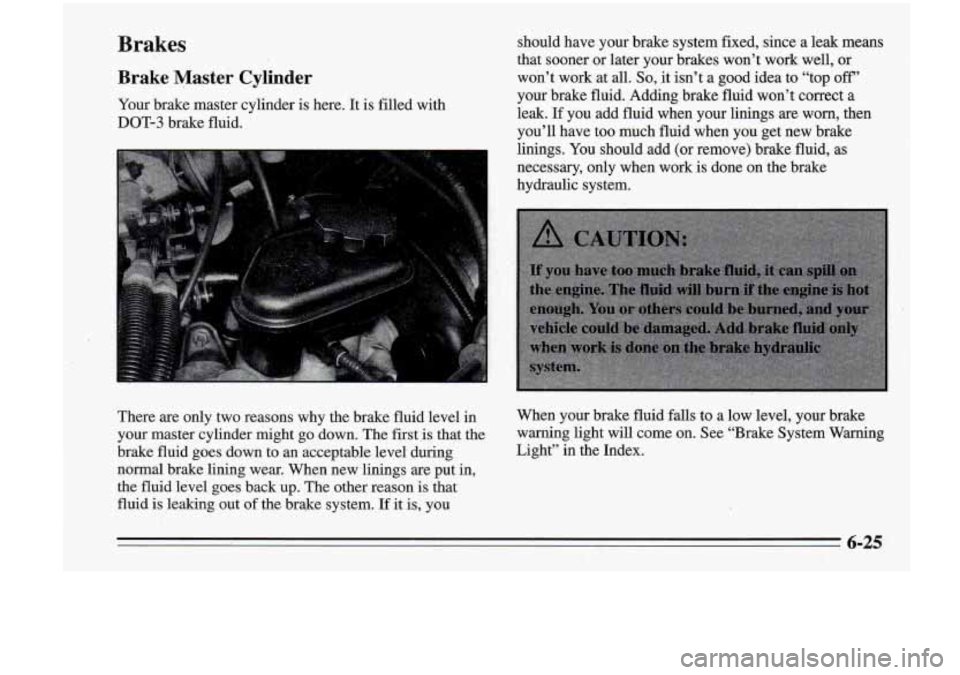
Brakes
Brake Master Cylinder
Your brake master cylinder is here. It is filled with
DOT-3 brake fluid. should
have your brake system fixed, since a leak means
that sooner or later your brakes won’t work well, or
won’t work at all.
So, it isn’t a good idea to “top off’ I I
your brake fluid. Adding brake fluid won’t correct a
leak. If you add fluid when your linings are worn, then
you’ll have too much fluid when you get new brake
.linings.
You should add (or remove) brake fluid, as
necessary, only when work is done on the brake
hydraulic system.
There
are only two reasons why the brake fluid level in When your brake fluid falls to a low level, your brake
your master cylinder might go down. The first
is that the warning light will come on. See “Brake System Warning
brake fluid goes down to an acceptable level during, Light” in the Index.
normal brake lining wear. When new linings
are put in,
the fluid level goes back up. The other reason is that
fluid is leaking out of the bree system. If
it is, you
Page 300 of 340
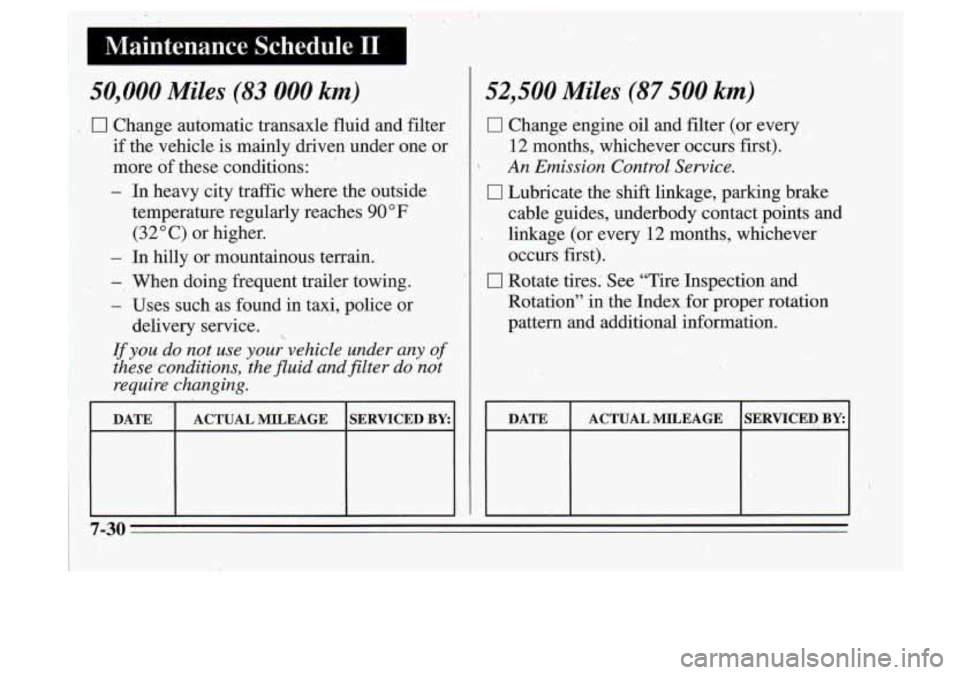
. .50,000 Miles ,. (83 000 km)
‘i 0 Change automatic transaxle fluid and filter
if the vehicle, is mainly driven under one or
more of these conditions:
- In heavy city
..
traffic where the outside
temperature regularly reaches
90 “F
(32°C) or higher.
- In hilly or mountainous terrain.
-, When doing frequent trailer towing.
- Uses such as found in tax& police or
Ij’you do not use your vehicle under any
of
these conditions, the fluid and filter do not
require changing. delivery
service.
DATE ACTUAL MILEAGE SERVICED BY:
52,500 Miles (87 500 km)
0 Change engine oil and filter (or every
12 months,’ whichever occurs first).
An Emission Control Service.
0 Lubricate.the shift linkage, parking brake
cable guides, underbody contact points and
. linkage (or every 12 months, whichever
occurs first).
0 Rotate tires. See “Tire Inspection and
Rotation” in the Index. for proper rotation
pattern and additional information.
’. .
DATE ACTUAL MILEAGE . SERVICED BY:
!’
Page 311 of 340
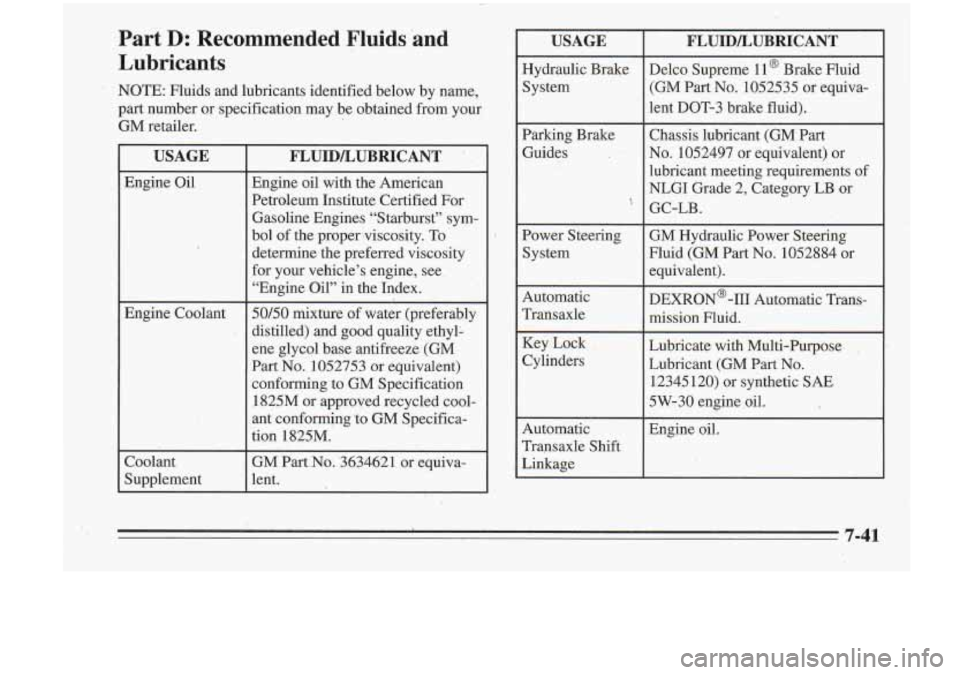
Part D: Recommended Fluids and
Lubricants
NOTE: Fluids and lubricants identified below by name,
part number or specification may be obtained from your
GM retailer.
USAGE
Engine Oil
Engine Coolant
Coolant
Supplement
FLUIDLUBRICANT ’ .
Engine oil with the American
Petroleum Institute Certified For
Gasoline Engines “Starburst” sym-
bol of the proper viscosity.
To
determine the preferred viscosity
for your vehicle’s engine, see
“Engine Oil” in the Index.
50/50 mixture of water (preferably
distilled) and good quality ethyl-
ene glycol base antifreeze (GM
Part No. 1052753 or equivalent)
conforming to GM Specification
I825M or approved recycled cool-
ant conforming
‘to GM Specifica-
tion 1825M.
GM
PartNo. 3634621 or equiva-
lent.
USAGE
Hydraulic Brake
System
Parking Brake Guides
I
Power Steering System
Automatic
Transaxle Key Lock
Cylinders
Automatic
Transaxle Shift
Linkage
FLUIDLUBRICANT
Delco Supreme 11 Brake Fluid
(GM PartNo. 1052535 or equiva-
lent DOT-3 brake fluid).
Chassis lubricant (GM-Part
N.o. 1052497 or equivalent) or
lubricant meeting requirements
of
NLGI Grade 2, Category LB or
GC-LB.
GM Hydraulic Power Steering
Fluid (GM Part
No. 1052884 or
equivalent).
DEXRON’-III Automatic Trans-
mission Fluid.
Lubricate with Multi-Purpose.
,
Lubricant (GM Part No.
1,2345 120) or synthetic SAE
5W-30 engine oil.
Engine oil.
7-41
Page 328 of 340
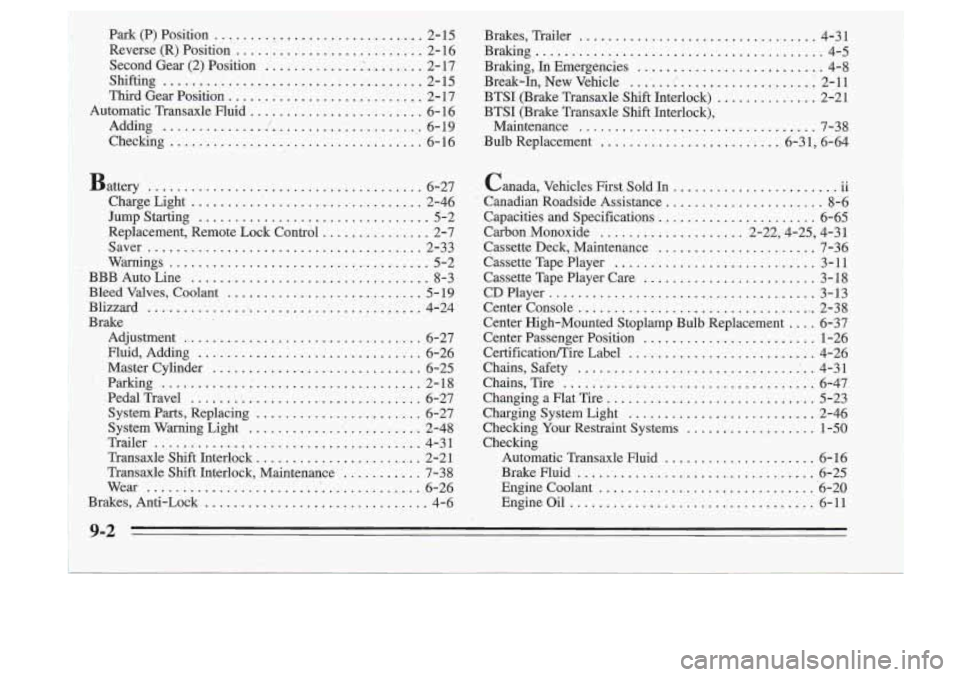
.. Park (P) Position ........ .................... 2- 15 Brakes. Trailer ................................. 4-31
Reverse(R). Position
.......................... 2-16 Braking ........................................ 4-5
Second Gear (2) Position
....................... 2-17 Braking, In Emergencies .......................... 4-8
ng
..................................... 2- 15 Break-In, New Vehicle ...... 1 ................... 2-11
c Transaxle Fluid
........................ 6- 16 BTSI (Brake Transaxle Shift Interlock),
rd Gear Position
........................... 2- 17 BTSI (Brake Transaxle Shift Interlock) .............. 2-21
Checking
................................... 6-16 Bulb Replacement ..................... ... 6-31, 6-64
Adding
.............. ! ...................... 6-
19 Maintenance ................................. 7-38
:Battery
...................................... 6-27 Canada, Vehicles First Sold In ....................... 11 ..
Charge Light ................................. 2-46 . Canadian Roadside Assistance ...................... 8-6
.Jump Starting
........... .................... 5-2 Capacities and Specifications ...................... 6-65
. Replacement, Remote Lock Control ............... 2-7 Carbon Monoxide .................... 2-22,4-25, 4-31
Saver
...................................... 2-33 Cassette Deck, Maintenance ...................... 7-36
Warnings
..................................... 5-2 Cassette Tape Player ............................ 3-11
uto Line
................................. 8-3 Cassette Tape Player Care ........................ 3-18
Center High-Mounted Stoplamp Bulb Replacement
.... 6-37
. Adjustment .................................. 6-27 Center Passenger Position ........................ 1-26
.Fluid, Adding
............................... 6-26 Certificatiomire Label .......................... 4-26
:Bleed Valves,
Coolant
........................... 5- 19 CD Player ...................................... 3-13
..:Blizzard
........................................ 4-24 Center Console .................................. 2-38
.. .Master Cylinder .............................. 6-25 Chains, Safety .................................. 4-31
Parking
............ : ....................... 2- 18 Chains, Tire ................................... 6-47
Pedal Travel
................................. 6-27 Changing a Flat Tire ............................. 5-23
System Warning Light
......................... 2-48 Checking Your Restraint Systems ........... , ....... 1-50
Trailer
..................................... 4-3 1 Checking
System Parts, Replacing
....................... 6-27 Charging System Light .......................... 2-46
Transaxle Shift Interlock
....................... 2-21 Automatic Transaxle Fluid ..................... 6-16
Transaxle Shift Interlock, Maintenance
........... 7-38 BrakeFluid ................................. 6-25
Wear
....................................... 6-26 Engine Coolant .............................. 6-20
' Brakes, Anti-Lock ............................... 4-6 Engineoil .................................. 6-11
I 9-2
I .